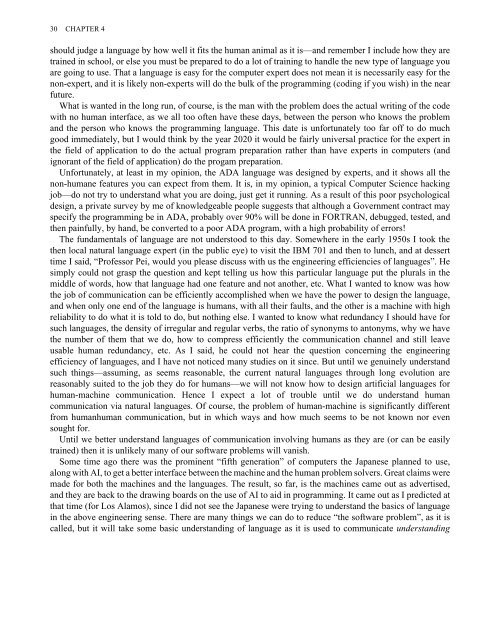hamming
hamming
hamming
Create successful ePaper yourself
Turn your PDF publications into a flip-book with our unique Google optimized e-Paper software.
30 CHAPTER 4should judge a language by how well it fits the human animal as it is—and remember I include how they aretrained in school, or else you must be prepared to do a lot of training to handle the new type of language youare going to use. That a language is easy for the computer expert does not mean it is necessarily easy for thenon-expert, and it is likely non-experts will do the bulk of the programming (coding if you wish) in the nearfuture.What is wanted in the long run, of course, is the man with the problem does the actual writing of the codewith no human interface, as we all too often have these days, between the person who knows the problemand the person who knows the programming language. This date is unfortunately too far off to do muchgood immediately, but I would think by the year 2020 it would be fairly universal practice for the expert inthe field of application to do the actual program preparation rather than have experts in computers (andignorant of the field of application) do the progam preparation.Unfortunately, at least in my opinion, the ADA language was designed by experts, and it shows all thenon-humane features you can expect from them. It is, in my opinion, a typical Computer Science hackingjob—do not try to understand what you are doing, just get it running. As a result of this poor psychologicaldesign, a private survey by me of knowledgeable people suggests that although a Government contract mayspecify the programming be in ADA, probably over 90% will be done in FORTRAN, debugged, tested, andthen painfully, by hand, be converted to a poor ADA program, with a high probability of errors!The fundamentals of language are not understood to this day. Somewhere in the early 1950s I took thethen local natural language expert (in the public eye) to visit the IBM 701 and then to lunch, and at desserttime I said, “Professor Pei, would you please discuss with us the engineering efficiencies of languages”. Hesimply could not grasp the question and kept telling us how this particular language put the plurals in themiddle of words, how that language had one feature and not another, etc. What I wanted to know was howthe job of communication can be efficiently accomplished when we have the power to design the language,and when only one end of the language is humans, with all their faults, and the other is a machine with highreliability to do what it is told to do, but nothing else. I wanted to know what redundancy I should have forsuch languages, the density of irregular and regular verbs, the ratio of synonyms to antonyms, why we havethe number of them that we do, how to compress efficiently the communication channel and still leaveusable human redundancy, etc. As I said, he could not hear the question concerning the engineeringefficiency of languages, and I have not noticed many studies on it since. But until we genuinely understandsuch things—assuming, as seems reasonable, the current natural languages through long evolution arereasonably suited to the job they do for humans—we will not know how to design artificial languages forhuman-machine communication. Hence I expect a lot of trouble until we do understand humancommunication via natural languages. Of course, the problem of human-machine is significantly differentfrom humanhuman communication, but in which ways and how much seems to be not known nor evensought for.Until we better understand languages of communication involving humans as they are (or can be easilytrained) then it is unlikely many of our software problems will vanish.Some time ago there was the prominent “fifth generation” of computers the Japanese planned to use,along with AI, to get a better interface between the machine and the human problem solvers. Great claims weremade for both the machines and the languages. The result, so far, is the machines came out as advertised,and they are back to the drawing boards on the use of AI to aid in programming. It came out as I predicted atthat time (for Los Alamos), since I did not see the Japanese were trying to understand the basics of languagein the above engineering sense. There are many things we can do to reduce “the software problem”, as it iscalled, but it will take some basic understanding of language as it is used to communicate understanding


